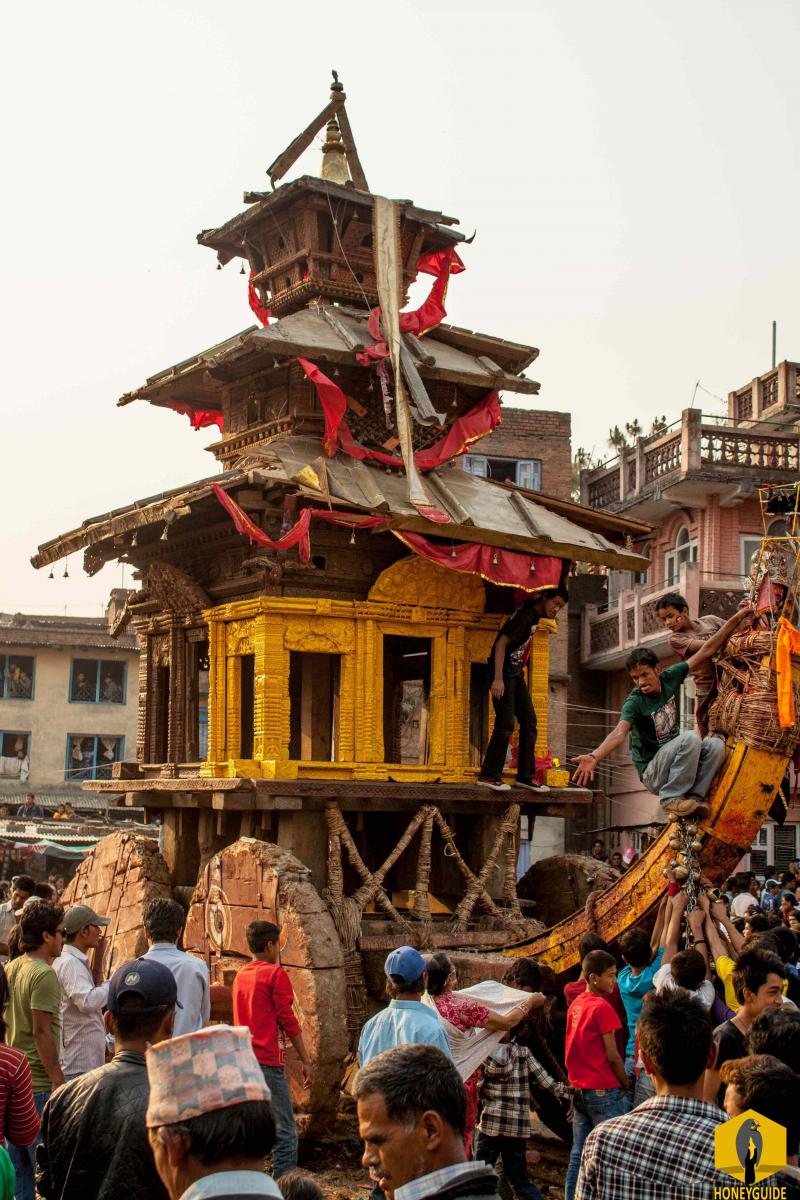Festival without mythical stories and rich cultural history are not just possible!! Well, it could be possible but won't have the same classical & historical appeal. Bisket Jatra has significant mythological touch on why it is celebrated since the Lichchhavi era ( 400 A.D- 750A.D) which is observed for nine days. It’s a celebration in commemoration of victory over two snakes responsible for making the princess into widow many times over. Two of most powerful indigenous deities are also celebrated in this great festival, the wrathful god Bhairava and the goddess Bhadrakali.
Bisket Jatra is a lively festival and the source of all the liveliness are the two chariots of the God Bhairava and Goddess Bhadrakali. A huge and hefty chariot carrying images of the god Bhairava is hauled by hundreds of locals to its resting place named Khalna Tole. The chariot slog around town, the main purpose to give the people a sight of their Gods and pay respects and offerings from right in front of their own houses or in their own neighbourhood. The chariots are meant to be hauled by every able-bodied local male; participation in it is seen as an honourable way to pay respects to their deities. A lot of the chariot pullers are intoxicated on local rice beer or other local liquor and it is their masquerade that make things lively. Its is that very holy spirited debauchery that many people come to see and be a part of.
After going through the alleys of Bhaktapur, at their resting place at Khalna Tole. Here, on Nepali New Year eve, a large 80 feet wooden pole is erected. The erected pole symbolises male genital and the stone on which it is erected represents female genital. The unity now symbolises fertility. On New year’s day it is pulled down in a tug-of-war game by two divided groups, sometimes also representing people from different parts of Bhaktapur city. As the pole hits the ground, New Year officially commences.
Here are some interesting stories related to the celebration of Bisket Jatra:
Slaughtering of snakes
According to mythology, every man who married the Princess of the Bhaktapur died the honeymoon night. Then a brave prince from another country married a Princess and stayed awake for his first wedding night. Soon two serpents came out of nostrils of the princess while asleep. The brave Prince took out his sword and chopped the serpents’ heads off their bodies. A different version of the story says it the Tantric powers of the new groom that killed the serpents. Hence the celebration for the victory over demon snakes. An eighty-foot lingam (pole) carved from a tree stands fluttering with banners representing two serpent demons slaughtered by the prince. The gigantic lingam is pulled down to the earth and the moment it hits the ground, the old year dies with the snake demons. It’s the sign that New Year has begun.
Consummation and fertility
This festival are also closely related to the consummation and fertility. At midnight, the chariots of Bhairab and Bhadrakali are brought together to symbolize copulation. The Bhairab chariot does not move instead the Bhadrakali chariot keeps dashing passionately to the Bhairab at midnight. The fall of the pole during the Bisket Jatra heralds Bikram Sambat New Year and the collision of the chariots stands for the ritual consummation and ultimately represents fertility.
Tongue-piercing
The practice of tongue is all over the world, albeit for different Gods. Nine Emperor Gods Festival celebrated in East-Asian countries with different names exhibit tongue-piercing to another level. However, the intention of people from different regions are the same, honoring their Gods. In Nepal, it is practised to this day but during Bisket Jatra only. Obviously painful but pulling it off implies that only a blessed person can bear the pain. It is believed that the painful act will bring good fortune to the villagers. This takes place in Bode, Bhaktapur. A volunteer from Shrestha clan pierces his tongue with an iron spike and walks around the town in a massive procession to honor the god.
Male Child
The lingam which is about 80 feet tall is adorned with a plant on its top. Energetic youths attempt to climb the pole, using big ropes in order to touch the plants. It is believed that whoever is able to do so will increase his probability of having a son. Being a patriarchal society having a son is considered to be the boon for the family.
Brick-pelting
The two divided groups of eastern and western Bhaktapur have a historic story behind the brick-pelting act. It is not known conclusively whether this act is a deliberate action as symbolic re-enactment of an ancient feud or just random brawls initiated by intoxicated minds in that chaos. Both the stories have someone vouching but there is no doubt that such acts are the main attraction of the festival, or at least to a majority of visitors who are not from Bhaktapur. It is natural that, no one prefers to be second to worship the gods and a brawl ensues. Thanks to local authorities and community elders, such brawls have become a thing of the past and old habits die hard and a sign of potential brawls can be seen often but authorities are quick to react.
If the description above motivatated you to see this festival for yourself here are the dates for 5 more years to come:
2016- April 13
2017- April 14
2018- April 14
2019- April 14
2020- April 13








